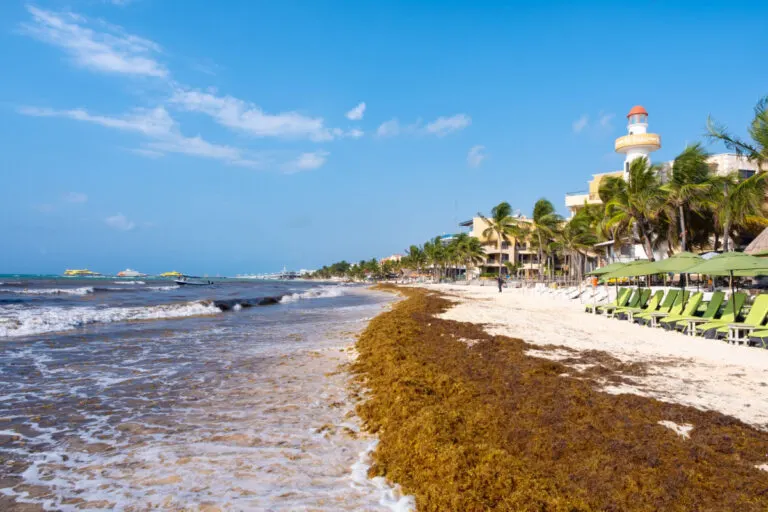At certain times of the year sargassum seaweed is unavoidable in many Caribbean beach destinations. But a massive seaweed invasion has the potential to ruin your vacation.
Sargassum seaweed can impact the appearance of your favorite beach; it can be smelly, and in some cases, it can even create a hazardous environment for humans.
Hoping to plan your next vacation to avoid sargassum?
A new report has found that these 3 destinations could see record-breaking sargassum seaweed invading beaches soon:
Mexico
The unattractive and inconvenient sargassum is expected to arrive in Mexico by April or May.
This could result in beaches that are overrun with brown seaweed and are difficult for travelers to enjoy.
The good news is that Mexican authorities take sargassum seaweed very seriously.

The Quintana Roo Technical Council for Sargassum Management is already following the path of this year’s sargassum mass and plans to deal with this seaweed before it reaches the most popular beaches in the region.
Tulum has invested heavily in 5 new anti-sargassum vessels and other equipment to stop any of the sargassum from reaching the shore.
If you want to plan a sargassum-free vacation to Mexico in April or May then you could consider traveling to Mexico’s Pacific coast and destinations like Puerto Vallarta rather than to the Mexican Caribbean.

Pacific beaches aren’t impacted by sargassum seaweed in the Atlantic because this seaweed doesn’t migrate to the Pacific. Some of the prettiest beaches in Mexico are also located here, although the waters are a darker blue color and not quite as warm as they are in the Caribbean.
Florida
Florida is the U.S. State most widely impacted by sargassum, and just like in Mexico, the report says that it will arrive on Floridian beaches by April or May this year.
Most municipalities have plans in place for the removal of sargassum. This includes the use of tractors to manually remove as much sargassum from the beaches as possible. But when too much sargassum piles up on Florida’s beaches this can restrict beach access.

Sargassum is unpredictable. Though forecasters can say when they think it might appear, it is impossible to know exactly when, where, and how much seaweed will wash up on Florida’s beaches at any given time.
But you might want to consider booking a resort with a good pool complex so you’ll still have somewhere to relax and unwind by the water if sargassum makes relaxing on the beach impossible.
Caribbean
Although less widely publicized than in Mexico, the Caribbean struggles with sargassum seaweed on its beaches.
The large sargassum mass is expected to arrive in the northern Antilles by the beginning of February and will reach the Dominican Republic in March.

Jamaica, The Bahamas, and the Dominican Republic are 3 of the Caribbean islands most impacted by sargassum, but relatively few areas of the Caribbean aren’t affected.
Both manual labor and machinery are used to remove sargassum from beaches in the Caribbean before being moved to locations away from the beach.
Why Is Sargassum Problematic?
Sargassum seaweed is a naturally occurring brown algae bloom. Wondering whether you should still plan a vacation if your chosen resort beach is covered in sargassum seaweed?

While sargassum serves an important purpose when it is in the ocean on the shore, it is unattractive and releases a smell that is similar to either manure or rotten eggs. Not exactly the relaxing beach vacation you were dreaming of!
As well as being unsightly, there are also risks when beaches are covered in sargassum. Although sargassum beaches are generally safe to swim in, they look brown and uninviting. The sargassum can also feel uncomfortable when it scratches against your skin.
After 48 hours of being on the beach, sargassum starts to rot. When it rots it releases hydrogen sulfide which is a skin irritant and can also be hazardous to anyone with a respiratory problem like asthma.

But many resorts work hard to remove sargassum from their beaches for the comfort and convenience of their guests.
You should consider checking with your hotel or the local authorities that your closest beach is located in to make sure they have a management plan in place for the sargassum’s removal.
Beach webcams can also be handy for assessing what the current sargassum situation is in your chosen destination. And arrange to spend time by the pool or other activities away from the beach so that your vacation won’t be ruined if the beach isn’t accessible during your trip.
Credit: Source link

